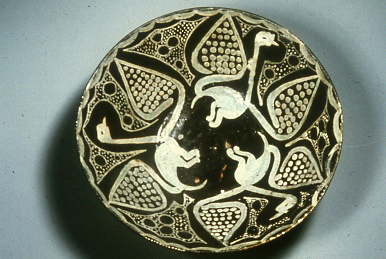Identities & Islam: Material Culture, Self and Society in the Pre-Modern Muslim World was the inaugural UK Early Career Symposium on Islamic Archaeology.

It was my first virtual conference: with the speakers in Southampton, and me watching at home (and others wherever they were). I wanted to share some of the points the keynote speaker, Dr Alan Walmsley, made (as I, virtually of course, understood them).
Dr Walmsley spoke about the Nishapur excavations in 1935-48 by CK Wilkinson, as an example of how objects could be made into orphans.
He spoke of how the market created by academic excavation of objects produced an incentive to loot. How objects seen without context or what he called “parentage” were reduced when they were reborn as “art objects” analysed using the rules of Western art history. And how this art historical approach affects how the fragments of context – any parentage that might remain – are (mis)understood. False cultural models are created.

Scholarship is especially tainted by the construction of false contrasts (he gave as an example the “ordered classical” city, as compared to the “chaotic oriental” city). And those false contrasts suggest .. support .. even create an inevitable cultural conflict.
Dr Walmsley pointed out that the bowls from Nishapur were of especial interest when they were excavated as their stylised designs fitted into the then-contemporary Art Deco (actually most flourishing in the 1930s and 40s). So, there popularity was much more related to the Western art market than anything happening in Nishapur when the pieces were made.
I was very interested to hear these ideas – my view of the many Safavid-era ceramics is that they were created in response to / creating a burgeoning market, rather than as one-off artistic masterpieces. So I do wish there was more work on the marketplace, rather than only looking at the details of the motifs.
A. W. drew attention to the traditional western point of view when considering Western Asian archaeology since the Egyptian campaign of Napoleonn: from Bible archaeology to A.U. Pope. He emphasised the descriptive as seen in Creswell and Hertzfeldt. He could have mentioned Susa where only from the 1970s was the Islamic level taken into accouint. But even then the finds were not put into context. Indeed objects were usually “orphans” in an alien collector or museum context. Private homes, ceramic, metal departements!
A. W.’s rethinking was to place archaeological sites and their objects within their own historical context: where to look for the early mosque in Jerash within the Roman-Christian context or in Aleppo the mosque, peace be with it, next to the church of St Helena or the first mosque in Damascus next to the Christian church as seen by Christian pilgrims. His comments of the reshaping of areas, the redifining of purposes of buildings, thus analysing the transition from Christian to eary Islamic rule, not a quick move. Islamic archaeology deals with society beyond the artifacts.
In the same conference Rana Daroosheh analysed the Iranian approach to archaeology from classical under foreigners to a populist approach after 2005. Under Katami there was some dialogue between the different civilisations throughout the history of Iran etc….
One certainly wishes for more of these conferences on linenow that researchis totally worldwide.
Thanks, Caroline, for drawing attention to the Southampton University initiative.